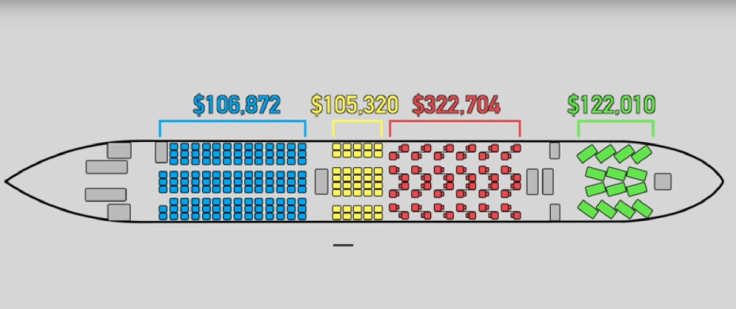How do airlines make their money? Hint – it's not by selling economy seats
There's a reason why airlines spend less on their economy cabins.
The majority of us have no option but to travel economy class when flying, which for the most part, means the bare minimum in legroom and a cramped cabin.
But it is a common misconception that airlines – traditional ones like British Airways rather than low-cost carriers such as Ryanair – make their money from selling economy seats.
In actual fact, they are drawing most of their income from the premium seats, such as first and business class. On average, around two-thirds of any airlines' revenue comes from passengers in first, business or premium economy class.
The YouTube channel Wendover Productions has delved into the economics of airline travel to explain how airlines make their money.
" The real money, at least for the traditional airlines, is in premium cabins. Let's take, for example, the British Airways 777," the video explains. "There are 224 total seats on this plane and it flies daily between London Heathrow and Washington Dulles airport.
"A round-trip economy class ticket leaving March 15th and returning on March 22nd costs, at the time of writing, $876 (£708). That means that, if each of the 122 economy seats is filled, the entire back section of the plane will make the airline, round-trip, $106,872 (£86,466)."

Comparatively, the going rate for a premium economy seat is $2,633 (£2,130) for a round-trip, meaning the entire cabin will make $105,320 (£85,210).
"Already you can see that the entire 40-seat premium economy sections makes British Airlines roughly as much as the entire economy class section."
For business class, the 48 seats fetch $6,723 (£5,439) each for a return fare, making the airline $322,704 (£261,087).The 14 first class seats are sold for $8,715 (£7,050) each or $122,010 (£98,713) total.
There are other factors such as the amount airlines spend on food for passengers. However, the explainer does go into how airlines classified their cabins.
"In the beginning of commercial aviation, there weren't really any classes because everything was premium. That's not to say that planes were very luxurious – a 1920s plane looked like this – but flying was just so expensive that the experience of flying was the luxury itself.
"It's kind of like how you don't see Virgin Galactic selling first, business and economy class seats on their planned tourist flights to space. The experience itself is the luxury. Once commercial space travel becomes commonplace, we'll almost certainly certainly see a classification of the experience but until a transport method is at a cost where it's attainable to the normal person, it's all first class."
© Copyright IBTimes 2024. All rights reserved.






